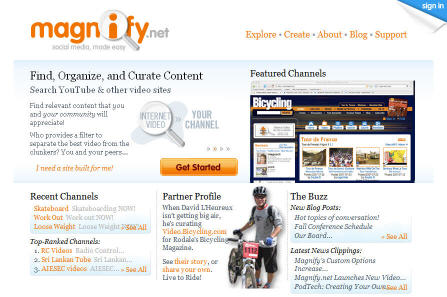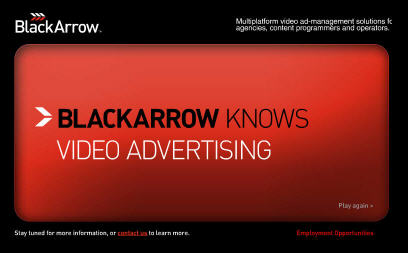-
Bud.TV + New Yorker = ?
Thumbing through the latest version of the New Yorker I noticed the ad shown at right (scanned B&W
 version, a little hard to read online). It's an intriguing invitation to enter something called the "Bud.TV Movies Rock BudTUBE" contest (that's a mouthful). It goes on to ask you to "reinterpret" one of the featured movie scenes on Bud.TV. The winner gets a trip to LA and a possible meeting with producer Stacey Sher.
version, a little hard to read online). It's an intriguing invitation to enter something called the "Bud.TV Movies Rock BudTUBE" contest (that's a mouthful). It goes on to ask you to "reinterpret" one of the featured movie scenes on Bud.TV. The winner gets a trip to LA and a possible meeting with producer Stacey Sher.So I go to Bud.TV to learn more and all I can find is a small icon on the home page that leads to this contest landing page.

It doesn't say when this contest will launch, doesn't ask me to submit an email address or to sign up to be notified when the contest goes live and doesn't provide any additional teaser information beyond what was in the New Yorker ad (like how about at least showing a few of the featured movie scenes?).
At first I thought the New Yorker magazine, with its liberal-minded, somewhat elitist audience, seemed like an odd place to be marketing a contest sponsored by a beer brand, but maybe there was something I was missing. But now seeing this underwhelming landing page, my conclusion is that this whole Bud.TV contest is a misfire so far. Wouldn't you expect a marketer of Anheuser-Busch's stature to execute the details better than this? I would.
Bud.TV has been widely criticized, but it remains a bold attempt by Bud to use broadband to change the marketing equation and improve engagement with its customers. However, if it's going to be effective, it's going to have to execute far better than it has with this contest. A lesson to all brand marketers experimenting with broadband - try your best to create a cohesive and memorable user experience.
Categories: Brand Marketing, Magazines
Topics: Anheuser-Busch, Bud.TV, New Yorker
-
Magnify.net: A Long Tail Matchmaker
 Yesterday I had a chance to catch up with Steve Rosenbaum, CEO and Co-Founder of Magnify.net.
Yesterday I had a chance to catch up with Steve Rosenbaum, CEO and Co-Founder of Magnify.net.One of the things I really enjoy about being an analyst in the burgeoning broadband video industry is getting first-hand exposure to all the clever innovation that's going on. I find it endlessly fascinating to hear directly from entrepreneurs on the front lines where the kernel of their idea came from which led to their business plan. A user experience issue? A technology deficiency? A business model flaw? Over the years I've heard many stories. Some kernels have real weight, while some don't quite resonate for me.
Magnify.net falls into the former category. My read is that this is a company trying to solve a real problem with a very clever solution and the right "corporate attitude" to make it a likely winner.
Magnify is actually solving a number of real problems, many of which relate to the highly distributed or "Long Tail" nature of the Internet and broadband video. First is that while consumers love broadband video, finding what they want is problematic. Novelty quickly turns to frustration when rummaging through big video sharing sites to find something relevant. No matter how much users want choice, some level of editorial or "curation" is essential to optimize their experience.
Magnify enables existing enthusiast or vertical web sites (whether independent or major media) to obtain video from the best video sharing sites (YouTube, Metacafe, etc.) and coherently present a screened assortment to their users. The sites' use their editorial skills to sort the wheat from the chafe, with easy-to-use admin tools ensuring that no offending video slips through the cracks.
So the second problem Magnify solves is enabling thousands (17,500 and counting to be exact) of sites to provide quality video to their users without the hassle and expense of creating it themselves (the "matchmaker" role). These sites get 50% of the revenue from the ads Magnify sells around the video (or they can keep up to 50% of the inventory to sell themselves), leveraging their audience and subject matter expertise. Incorporating video into web sites is becoming online table stakes. I agree with Steve, in the years ahead, sites without video are going to look "charming".
The only real hole I can find in Magnify's model is that it doesn't currently compensate the content creators themselves (a la Revver for example). However I'd expect that to change as creators upload directly to Magnify and the company's network and traffic builds out over time.
Lastly, I like Steve's attitude. He views the market as an incredibly expanding pie, and not "winner take all." As a result, while there are others who touch on Magnify's space (Brightcove, ROO, VideoEgg, Ning, KickApps, etc.), he's less concerned about competition per se and matching feature-for-feature, but rather on responding to the needs and wants expressed directly by their own user base. Companies that do this ultimately win, regardless of competition.
The Magnify story plays into a number of areas I follow closely - the changing role and power of video distributors, the continued "nichification" of video, the challenge of video discovery and the reliance on ads, not subscription fees. To the extent that their approach succeeds it will further morph traditional video models. For a 10 person company that's only done an angel round, they've accomplished a lot in addressing genuine Long Tail issues in the broadband video industry. (Btw, TechCrunch has 2 great reviews, here and here).
Categories: Aggregators, Indie Video, Startups, UGC, Video Sharing
Topics: Brightcove, KickApps, Magnify.net, Ning, ROO, VideoEgg
-
Discovery and Scripps Networks Are Blazing Ahead
 The past two days have witnessed two very significant cable network-related transactions. First, Discovery announced its acquisition of HowStuffWorks for $250 million, its largest acquisition ever. And second, Scripps announced that it would separate itself into two companies, with its marquee networks, HGTV and Food Network, finally being pried free from the E. W. Scripps's traditional newspaper business.
The past two days have witnessed two very significant cable network-related transactions. First, Discovery announced its acquisition of HowStuffWorks for $250 million, its largest acquisition ever. And second, Scripps announced that it would separate itself into two companies, with its marquee networks, HGTV and Food Network, finally being pried free from the E. W. Scripps's traditional newspaper business.
I interpret these announcements as continued recognition by major cable networks that their futures lie squarely in the interactive and broadband video areas. These networks - and others - are laying the groundwork for an evolution from sole dependence on their traditional business model. That model has been a monster success over the years, built on ever-expanding distribution through cable and other multichannel platforms and annual increases in monthly affiliate fees.
With the advent of the Internet and broadband, the fragmentation of audiences, the proliferation of content startups and the strengthening of online advertising models, all cable networks realize that embracing interactive/broadband opportunities is critical to their future success.
Discovery's acquisition of HSW gives it a trove of broad and deep online content, some developed by HSW and some supplied by third parties, which will now be available to Discovery's multiple properties. In one fell swoop, Discovery gains scale and expertise, which must now be delicately integrated into its current on-air and online brands. If the integration of HSW's content is a success, it will become a template for other deals.
Meanwhile, the Scripps split up follows that of Belo, another lagging newspaper company. The standalone entity, Scripps Networks Interactive, will have a growth focus leveraging strong brands in some of the best lifestyle categories (food, home, luxury, etc.). With its own currency to do deals, I wouldn't be surprised to see Scripps ramp up its acquisition activity as it bolsters its position across all these categories (in fact CEO Ken Lowe said as much in the analyst call). Scripps has been a real leader among cable programmers in building out broadband extensions to its cable networks and I would expect to see that activity grow, accompanied by distribution deals with online distributors which have strong reach.
While the Discovery and Scripps deals are the latest evidence that the traditional cable programming world is undergoing significant change, I expect we'll see plenty more similar moves in the year ahead.
(Note while both Discovery and Scripps are clients, these are my opinions only and no confidential information has been relied upon)
Categories: Cable Networks, Deals & Financings
Topics: Discovery, Food Network, HGTV, HowStuffWorks, Scripps
-
YouTube Gets Serious About Copyright Protection with New Video ID Service
At long last YouTube has launched "Video Identification" in beta, its answer to copyright owners who feel
 YouTube has built its business on the back of their copyrighted content.
YouTube has built its business on the back of their copyrighted content. Having not seen the system in actual use, it's impossible for me to judge how well it works. But having read how YouTube describes its approach in developing the system, considering how it allocates responsibilities for copyright protection with the rights-holders themselves and thinking about the bigger picture challenges all media companies face in the broadband era, my initial reaction is that Video ID is a pretty good first step.
YouTube's approach - As the Video ID page says, YouTube was guided by 3 motivations in creating the system: accurate identification, choice for copyright holders and a great user experience. While there will be plenty of debate about how much emphasis each of these should have received relative to the others, my guess is that the DMCA's requirements and the health of YouTube's business drove the final balance. While YouTube has an image problem with major media which it would like to improve, nobody can expect that the company's SOLE motivation in developing a copyright protection scheme should be the concerns of copyright holders. Whenever I read a copyright holder complaining about YouTube or other piracy issues, I wonder, would these people only be happy if we returned to the pre-Internet age? Since that's not going to happen, less complaining and more adjusting is what's required of media companies now.
Allocating responsibilities - The most controversial part of Video ID will likely be the requirement that copyright holders provide their videos so YouTube can build its database against which to judge alleged pirated copies. The predictable reactions will be "it's too much work", "we don't trust that YouTube won't misuse it and "why should we?". There will be much second guessing whether other technical approaches not requiring submitting full video files would have been as effective. Of course nobody knows for certain, so at the end of the day either you trust that Google, with its pantheon of computer science experts, vetted the options well and selected the best choice, or you don't. It's ludicrous for lawyers and media executives who have never written a line of code in their life to suggest that Alternative A or Alternative B would have been better. I suggest that for now media companies give YouTube the benefit of the doubt. It is incumbent on YouTube to show it will be responsible with these video files and that having them really does make the Video ID system work well.
Bigger picture challenges - YouTube isn't going away, nor are the other video sharing sites. Broadband isn't going away either. And lastly, consumer behavior isn't going to change back what it was in the pre-Internet era. Media companies need to accept that the world is what it is, and learn to adapt themselves to it to succeed. My sense is that Video ID gives media companies all the options they should desire or expect: having the offending content removed, having it continue to run as promotional fodder, or making money off it through a revenue split (though these percentages are TBD). These tools, if they actually work, will give media companies lots of new flexibility to exploit their content with by far the largest audience of broadband video users. If media companies choose not to participate, shame on them for sticking their heads in the sand and wishing the world would return to a simpler time. YouTube has demonstrated for all of us what I believe and have said many times: that broadband is the single most disruptive influence on the traditional video industry. Companies that don't recognize this and don't work with the YouTubes of the world to adapt themselves will ultimately be rendered irrelevant or worse.
Categories: UGC, Video Search
-
Maven Moves the Broadband Video Ad Market Forward
Maven Networks got a lot of ink today with 2 announcements, first the launch of a new broadband ad platform and the second, the launch of a new industry collaboration dubbed the "Internet TV Advertising Forum." These have been in the works for a while and Maven gave me a heads up on both over the summer.
The Ad Forum is noteworthy, as it appears to be a genuine "good guy" effort to move the whole industry forward in optimizing the ad model. Ten companies signed on for launch, including heavies like Scripps, Fox News, Oglivy, TV Guide, Microsoft, DoubleClick and 24/7.
I caught up by phone with Kristen Fergason, Maven's VP of Marketing to learn more. First, the Forum is completely open to everyone. Though initially underwritten by Maven, over time it will probably take on more of a "dues-paying" model. And to show that "open" really does mean open, I asked what happens if competitors like Brightcove for example, wanted in? Her reply: "we'd happily accept them".
The forum is mean to bring together agencies, content providers and vendors to build consensus about how to move past the market's current reliance on pre-rolls. Kristen said industry players have been "chomping at the bit" to get involved and Maven received 40 applications today alone. Importantly, the Forum is meant to augment IAB initiatives, not compete with them. The Forum will run focus groups and collect research based on ideas generated by Forum members to see what works and what doesn't. Results will be available to everyone.
Maven believes that a "rising tide lifts all ships", but because its ad platform is ready now, it will benefit disproportionately. That's where today's other announcement comes in. The demo I saw shows how new ad units (videos, overlays, banners, etc.) can be dynamically inserted, not just at the beginning of the video, but throughout. The result is that a lot of new inventory is available. The below graphic shows "cue points" for manual insertion, but an algorithm can also be used to insert based on what the system knows about things like clip length, average user session time, click-thru, etc. Note I didn't see this feature in action, so I can't say for sure how well it actually works.
 There's also pretty neat telescoping transaction capability as shown below, which allows the content provider or advertiser to collect specific user information. The video resumes when the user is done.
There's also pretty neat telescoping transaction capability as shown below, which allows the content provider or advertiser to collect specific user information. The video resumes when the user is done. The ad platform looks like a solid entry and when taken together with other myriad ad initiatives in the market, everything suggests that we may actually see life beyond pre-rolls. Hallelujah.
The ad platform looks like a solid entry and when taken together with other myriad ad initiatives in the market, everything suggests that we may actually see life beyond pre-rolls. Hallelujah.Categories: Advertising, Technology
Topics: 24/7, Brightcove, DoubleClick, Fox News, Maven, Microsoft, Oglivy, Scripps, TV Guide
-
Black Arrow Shoots for Multiplatform Ad Success
 Black Arrow has an ambitious goal of managing and serving ads across broadband video, DVR and VOD platforms. With audience fragmentation causing chaos in the advertising world, such a solution, when fully implemented, would have enormous value to content companies and service providers (cable, satellite, telco).
Black Arrow has an ambitious goal of managing and serving ads across broadband video, DVR and VOD platforms. With audience fragmentation causing chaos in the advertising world, such a solution, when fully implemented, would have enormous value to content companies and service providers (cable, satellite, telco).Black Arrow has been around for a while but went under the radar for the past few months. Now it's re-emerging, with new CEO Dean Denhart installed about 6 months ago.
Dean briefed me last week on news the company announced today, which included closing a $12M B round from existing investors Comcast, Cisco, Intel, Mayfield and Polaris and officially launching their ad platform.
The company is trying to differentiate itself from many others serving ads in the broadband video space by tackling the thorny problem of also inserting in both the DVR and VOD environments. DVR insertion today is non-existent and for VOD it's not scalable. To succeed, the company will need to integrate its servers with the service providers, which is no easy feat. As many of you know, the rap on cable operators - and I've experienced this first-hand - is that selling into them wears out early-stage companies, using up precious time and capital in long drawn-out testing, selling and negotiation cycles.
If Black Arrow survives this process and proliferates its gear into headends, it will have a formidable competitive advantage against competitors. And on the encouraging side, in the cable world at least, a nascent set of standards dubbed "DVS 629" governing digital ad insertion is now being worked on. Black Arrow is following these closely. Dean explained that the company has proven in its technology and in 2008 it will be pursuing field trials and initial rollouts with major operators. Certainly having Comcast as a lead investor can't hurt its chances.
Black Arrow's real appeal to content companies will only begin when it has significant deployments. Dean explained that while the cable sell-in process continues to unfold, it will follow a parallel track of managing ads for broadband, with the longer-term value prop of multi-platform support. And it's taking a wait-and-see approach on which business model to use to fund the capex for proliferating its servers. An analogous and interesting approach is the one Akamai has mastered - i.e. not charging ISPs. Instead it positions its gear contributing to top-line growth and opex reductions. This strategy has been a massive success for Akamai, helping it achieve widespread deployments and a huge entry barrier for competitors.
I really like this company's vision; however achieving it in full is going to take tenacity, patient and deep-pocketed investors and a few good breaks.
Categories: Advertising, Cable TV Operators, Deals & Financings, Startups
Topics: Black Arrow, Cisco, Comcast, Intel, Mayfield, Polaris
-
Brand Marketers Jumping on Broadband Video Bandwagon

Question: What do Frito-Lay, Unilever, Neiman Marcus, Heinz, Toyota, Smirnoff and MGM have in common?
Answer: In just the last month each of these companies has announced plans to launch some type of broadband video marketing program. Beginning of a trend? You betcha.
Premier brands from one industry to another are recognizing the importance of using video to reach out to and engage better with their customers. Yet I read with interest this piece in yesterday'sWSJ, discussing a big marketers' conference that sold out for the first time ever this year. Adapting to the digital world is a top concern. A Booz Allen survey found that most marketers allocate only 5-10% of their ad budgets to digital media, while online usage continues to soar.
So kudos to the companies mentioned above and the others which are taking their first steps into the broadband world, trying to figure out what tactics work in this new era. Their efforts are varied and reflect the sense of experimentation pervading the market. Consider - Frito, Heinz and MGM are all using some type of content to incent UGC activity. Unilever's Dove soap and Smirnoff are posting original video on YouTube, trying to catch a viral wave. Meanwhile Toyota has devised a new Xbox game called "Yaris" after one of its cars.
As the Super Bowl season approaches, we can expect a lot more broadband video activity from the marketers. Almost 2 years ago I wrote, "The $10 Million Super Bowl Ad". It's worth a peek, I think we're heading in that direction as marketers realize how broadband tie-ins can breathe huge additional life into 30 second Super Bowl spots.
Categories: Brand Marketing, UGC
Topics: Frito-Lay, Heinz, MGM, Neiman Marcus, Smirnoff, Toyota, Unilever
-
Will eBay's Skype Write-down Hurt Joost and Other Video Players?
The news that eBay was going to write a portion of its Skype purchase did not really surprise many people, although its magnitude, $1.4B out of $2.6B paid still felt shocking. At the time of the deal, it seemed the only people who thought the deal made any sense were eBay's CEO Meg Whitman and her board. Whether they thought there was strategic sense to the deal or not, certainly Skype's founders Niklas Zennstrom and Janus Friis must have been grinning widely at the willingness of eBay to pay such a ridiculous premium for their company.This Times piece noted that:... revenue and earnings projections made by Skype executives before the sale to eBay turned out to be "a bit front-loaded" according to Mr. Zennstrom.
although its magnitude, $1.4B out of $2.6B paid still felt shocking. At the time of the deal, it seemed the only people who thought the deal made any sense were eBay's CEO Meg Whitman and her board. Whether they thought there was strategic sense to the deal or not, certainly Skype's founders Niklas Zennstrom and Janus Friis must have been grinning widely at the willingness of eBay to pay such a ridiculous premium for their company.This Times piece noted that:... revenue and earnings projections made by Skype executives before the sale to eBay turned out to be "a bit front-loaded" according to Mr. Zennstrom.Not to take anything away from the potential of Joost, the pair's much-heralded broadband video aggregator, but if you were considering making an investment in the company or any other in the video space, wouldn't this whole eBay-Skype affair make you cautious? Seeing such a gigantic writedown, and now the admission that the projections has to make prospective investors just a little more cautious about Joost, and all other video players as well.
I'm asked frequently, is there a bubble in the video space? I think the answer is that yes, investors are getting too enthusiastic, as they always do when they smell a transformative opportunity. The Skype writedown is a reminder to all investors in the space that being optimistic about broadband's potential is right, but keeping their sanity regarding valuations is critical. eBay just reminded all of us of the cost of not doing so.
Categories: Aggregators, Deals & Financings


